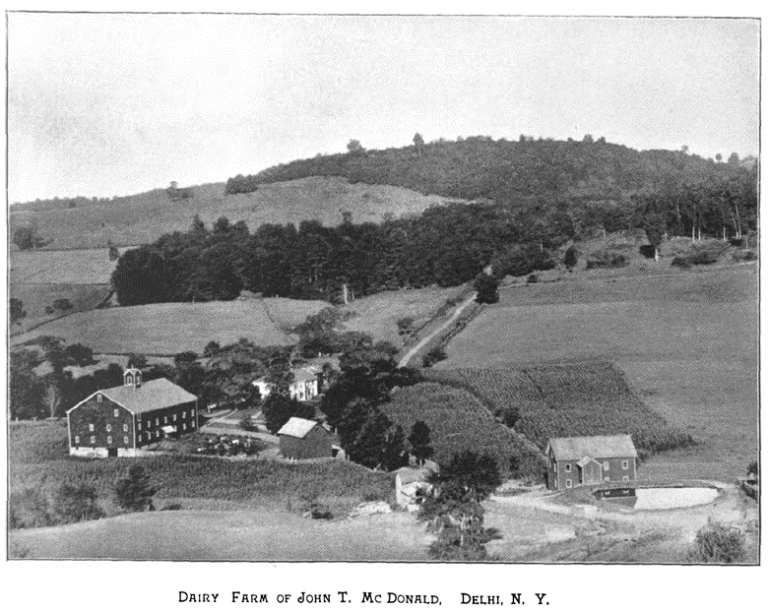JOHN T. MCDONALD
- Program
- Subject
- Location
- Lat/Long
- Grant Recipient
-
NYS Historic
-
Industry & Commerce, People
- 3928 Elk Creek Rd, Delhi, NY 13753, USA
- 42.351103, -74.864757
-
Meredith Historical Society
JOHN T. MCDONALD
Inscription
JOHN T. MCDONALDOWNED NOTED DAIRY FARM
HERE 1875-1924. IN 1899,
DEVISED SYSTEM TO GENERATE
ELECTRICITY FROM ELK CREEK FOR
HOME, FARM, CREAMERY & MILL.
WILLIAM G. POMEROY FOUNDATION 2024
John T. McDonald (1842-1924) owned and operated a noted dairy farm in Delaware County, New York from 1875 until his death in 1924. Mr. McDonald was widely regarded as an innovative farmer and businessman. He was recognized for his unique farming methods and his contributions to the advancement of dairy farming.
Throughout his career, Mr. McDonald’s successful dairy farm and agricultural methods were featured in publications as being distinctly progressive and innovative. This included multiple features in the national dairy farm magazine Hoard’s Dairyman, agricultural magazines such as American Agriculturist and Pennsylvania Farmer, and the weekly magazine The Outlook. On September 9, 1907, the U.S. Department of Agriculture, Bureau of Plant Industry, issued Bulletin No. 102, which included an article spotlighting Mr. McDonald’s farm entitled “A Successful Dairy Farm” written by L.G. Dodge, Scientific Assistant, Farm Management Investigations. The article was one in a series “giving the results of the study of systems of management on successful farms of various types.” It identified aspects that made Mr. McDonald’s farm unique and successful, including his innovative cropping system and “method of managing permanent grass land to maintain its productivity.” It noted:
“In spite of the simplicity of its cropping system, this farm has been rendered so productive as to provide many of the comforts and conveniences usually attributed to city life, and to maintain a large family at the same time.”
A significant aspect of Mr. McDonald’s dairy farm that was considered unique and innovative was that in 1899, he had devised a system to generate electricity for his farmhouse, farm buildings, and his creamery and mill buildings. Consistently noted for his mechanical ability, and described as a mechanical genius in contemporary publications (The Outlook, August 25, 1906; Pennsylvania Farmer, August 10, 1912), he developed and built a system and the machinery needed to capture power supplied by Elk Creek running through his property to feed a dynamo, or generator that provided power to run machinery for his sawmill, gristmill, cider press, a variety of other machinery, and an electric light machine with a capacity to run 50-75 lights. His residence, barns, cow stables, yards, creamery, and mill were all lit with electric lights. According to an article published in the August 25, 1906 issue of The Outlook, “The flume, installation, assembling of the machinery and the invention of some of it, [were] all the work of Mr. McDonald himself.” He did not view this as a luxury, and instead said this simply aided him in expanding working hours beyond daylight to increase the productivity of his farm (The Outlook, August 25, 1906).
Additional innovations included manufacturing wood cut from his property into packaging for his butter and farm products, including eggs, maple syrup, and apple cider. He processed the wood into packaging materials in his own sawmill, using machinery largely of his own invention. His home and farm had running water throughout, and his home and the three workers’ houses that he built were all plumbed with bathrooms in addition to furnaces for heating. He developed his own power cutter for cutting feed for his cows, along with a steaming room in the stable in which cut feed would fall to be steamed via perforated steam pipes in the floor (Hoard’s Dairyman, August 31, 1900).
Another characteristic noted as distinct was that Mr. McDonald did not send his products to market and instead did direct business with customers, with many remaining his clientele for decades. According to the February 19, 1904 issue of Hoard’s Dairyman, he “sold mainly to private customers in New York, Brooklyn and adjacent towns, and [brought] a price enough above the ordinary market rates to afford a remunerative profit.” His wife Catherine (1848-1909) was credited with helping him manage the business and customer relations.
Mr. McDonald passed away in 1924. His obituary published in the January 19, 1924 Oneonta Star recalled Mr. McDonald as an “estimable man and one of Delaware county’s most prominent farmers.” It went on to note that his was among “one of the best farms in Delaware county” with “many of the improvements about the farm [being] due to his unusual mechanical talent and were the production of his own hand.” After his passing, his daughters Elizabeth and Isabella kept the farm in operation until 1950. The land was eventually subdivided and sold off in parcels in the 1970s. As of 2023, Mr. McDonald’s former home, mill building, and portions of the barn and creamery are still standing along Elk Creek in Delaware County.

